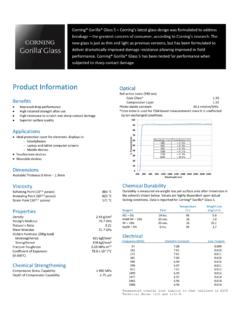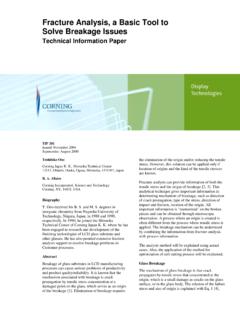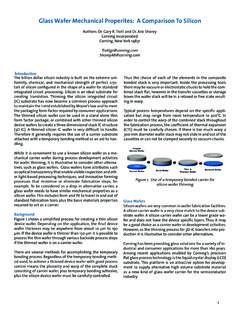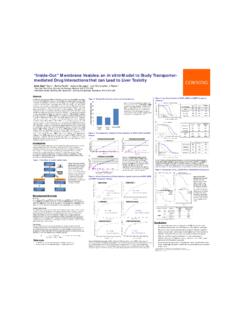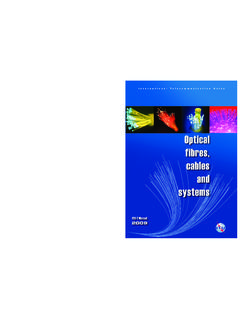Transcription of Frequently Asked Questions on Fiber Reliability - Corning
1 Frequently Asked Questions on Fiber Reliability White Paper WP5082. Issued: April 2016. Q I understand that Fiber optic cables only last 25 years in conduit and 15 years in aerial applications. Is this true? A No. There is no physical-chemical reason that properly designed, manufactured, and installed Fiber optic cable will not last as long as or longer than such times. There are numerous Fiber optic cables in operation around the world for these applications longer than those times. Tax depreciation schedules for Fiber optic cable are often 15 years or more. Operators installing optical cable typically presume a service life of 25 years. There is no reason to believe optical Fiber and optical Fiber cable will not last at least that long numerous optical cables around the world have been in service longer than that.
2 Q What is the theoretical lifetime of optical Fiber and optical Fiber cables? A There is no theoretical lifetime of optical fibers. There is no industry accepted wear out mechanism for optical Fiber . So there is no physical-chemical reaction to test and accelerate in order to predict an eventual failure mechanism and corresponding failure reaction rate. Q How long do optical fibers and cable last in practice? A In practice, optical Fiber cable has been in commercial use for over 30 years. There has been no endemic replacement or decommissioning of good quality cables installed in the early years of the industry what was installed back then is commonly still in operation. There is no general evidence to suggest they will not continue to perform for many more years. Numerous technical papers show optical cables recovered from the field still meet the optical specifications for which they were installed.
3 In fact, transmission equipment on cables installed in the 1980's by network operators around the world is routinely replaced with newer gear running data rates of 10 Gb/s or more using SONET/SDH and Ethernet technologies line rates and protocols not dreamed of when the cables were manufactured. It is common for customers to report to Corning that trial cables installed in the late 1970's or early 1980's are still in use today. That said, it is imperative to install good quality cable as any shortcomings in the quality of the cabling materials used to create the optical Fiber cable product can limit the ultimate lifetime of the cable materials, in particular the outer jacket. Q Are Fiber optic cables more reliable and have a longer service life than twisted pair metallic telephone cable ? A Yes, and this is accepted across the industry.
4 By needing to carry electric current, metallic telephony cables are subject to corrosion, short circuit/electrical faults, lightning strikes and other associated failure mechanisms. Fiber optic cables do not carry electrical current. Standard Fiber -to-the-Home architectures like Passive Optical Network require no powered equipment in the network. The consequential improvement in lifetime and Reliability is widely reported and accepted in the industry, and is quantified. Finally, the measured tensile strength of optical Fiber is 2 3X higher than metal alloys used for twisted pair telecommunications cable . Q I understand glass is a liquid and can flow or creep over time. This is evidenced by thickness variations in pre-Victorian era architectural windows. Does this not represent a Reliability concern for Fiber optics?
5 A This hypothesis has been disproven in the technical literature for many years. The thickness variation of windows of that era is attributed to the spin casting method used for their production during the day of course installers placed the thicker edges to the bottom of the frame for stability. Glass is only a liquid above the glass transition temperature (Tg) and a solid below that temperature. The glass transition temperature of optical Fiber is in excess of 1000 C, which is well above the service temperatures of Fiber optic cables . Q Does optical Fiber lose its ability for total internal reflection over time? A The refractive index profile of the optical Fiber is determined by the chemical composition of the glass. At temperatures conducive to human life those materials do not transport or degrade.
6 So over time total internal reflection is maintained. Q Isn't glass brittle? Isn't it weaker than metal wire? Won't it break over time? A The tensile strength of telecommunication grade optical Fiber is much higher than steel or other common materials. Telecommunication grade optical Fiber is routinely strength tested to at least GPa (100,000 psi) during manufacturing, but if you took a piece and loaded it to failure, it would likely break at 7 10 times higher load. Plus, supporting technologies in Fiber coating, optical cabling and installation have developed to preserve Fiber strength in the field. Q I've heard of optical cable failures, in various parts of the world. Do these present a Reliability concern? A Errors in production, processing, design, or installation have occurred with Fiber optic cables around the world, just like with any other product.
7 But to date where the initial cable quality and installation practices have been good and where in-service cable damage events have been not been excessive, no wholesale replacement of the installed Fiber optic cable infrastructure has been necessary and such good quality installed cable infrastructure continue to accept service upgrades to newer transmission protocols. Q What are the causes of failure in optical cables? A Numerous studies, including those by Telcordia and the USA government, show that the overwhelming source of failure for installed optical cables is extrinsic damage due to construction or excavation projects ( dig-ups ). Product degradation to failure and spontaneous product failure do not occur often enough to be considered in these studies. There is no accepted wear-out mechanism for optical Fiber .
8 More commonly, cables must be decommissioned and removed from service due to civics works projects ( , widening a road), or legacy transmission equipment can not be upgraded nor continued in service economically ( , TAT-8, the first trans-Atlantic trans-oceanic optical cable ). Corning Incorporated One Riverfront Plaza Corning , New York USA. Corning is a registered trademark of Corning Incorporated, Corning , Phone: (607)248-2000. Email: 2016, Corning Incorporated 2.


